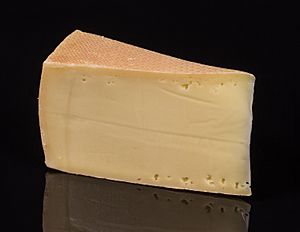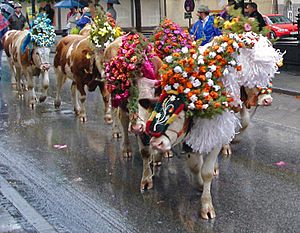Vorarlberger Bergkäse facts for kids
Quick facts for kids Vorarlberger Bergkäse |
|
|---|---|
 |
|
| Country of origin | Austria |
| Region | Bregenz Forest, Vorarlberg |
| Source of milk | Cows; hay milk |
| Texture | firm to hard, long-matured varieties may be crumbly |
| Fat content | 45% i. Tr. ("in der Trockenmasse") |
| Weight | up to 35 kg |
| Certification | PDO (since 1997) |
Vorarlberger Bergkäse is a special cheese from Vorarlberg, a state in Austria. Its name means "Vorarlberg mountain cheese." This cheese is very special because it has a "Protected Designation of Origin" (PDO) from Europe. This means it can only be made in certain areas of Vorarlberg using traditional methods. It helps keep the cheese's quality and history safe.
Contents
What Makes Vorarlberger Bergkäse Special?
Vorarlberger Bergkäse usually ages for 3 to 6 months. Some types can even age for up to 2 years or longer! This cheese is shaped like a big, round loaf. It is about 55 to 65 centimeters wide. Each cheese can weigh up to 35 kilograms, which is like a small dog!
The cheese from the Bregenz Forest often has small holes. These holes are a sign of good quality. The smell of the cheese can be mild or strong. It often tastes nutty and has hints of mountain herbs. About 45% of its dry weight is fat.
How Vorarlberger Bergkäse is Made
Vorarlberger Bergkäse is made only from fresh, natural milk. This milk comes from cows in specific areas. These areas include the Bregenz Forest, Großwalsertal, Kleinwalsertal, Leiblachtal, and the Rhine Valley. The cheese is made in special mountain dairies.
Traditional Farming Methods
In the Bregenz Forest, farmers use a very old way of raising cows. It is called "alpine transhumance." This means cows move to different mountain pastures depending on the season. From May to October, the cows eat fresh grass high up in the mountains. In winter, they eat hay from meadows in the valley. This way, the cows do not need to eat "silo feed."
The milk from summer cows is used to make "Alpkäse" right in the mountain dairies. From October to May, the milk is used to make Vorarlberger Bergkäse.
Checking the Quality
Making Vorarlberger Bergkäse is a careful process. It must be made by hand using traditional methods. The milk used has very strict quality rules. Only farms that mostly grow grass and do not use "silage" (fermented feed) can provide milk. This special milk is called "hay milk." Farmers must deliver the milk to the dairy at least once a day. It is then processed right away.
History of the Cheese
Making cheese has a long history in the Bregenz Forest. The Celts were the first to bring cows and mountain farming to this area. They used mountain pastures and made cheese a long time ago. However, for many years, they mostly made a different type of cheese called "sour cheese."
After a big war called the Thirty Years' War (1618–1648), cheese makers from Appenzell in Switzerland came to the Bregenz Forest. They taught the local farmers a new way to make cheese. This method was called "fat senning." It means they used all the milk, not just the skimmed part. This is how they started making "hard cheese." This new method led to the creation of Vorarlberger Bergkäse. Only natural rennet (a substance from animals that helps milk turn into cheese) is used.
By the mid-1700s, so much hard cheese was made in Vorarlberg that they could not sell it all locally. So, they started selling it to other places, especially Italy.
Cheese Making Today
In 1998, the Bregenz Forest Cheese Route was created. This group helps support local cheese making and old farming traditions. It connects farmers, sellers, and craftspeople. Along the Cheese Route, visitors can watch how cheese is made. They can also taste different cheeses.
See also
 In Spanish: Vorarlberger Bergkäse para niños
In Spanish: Vorarlberger Bergkäse para niños


